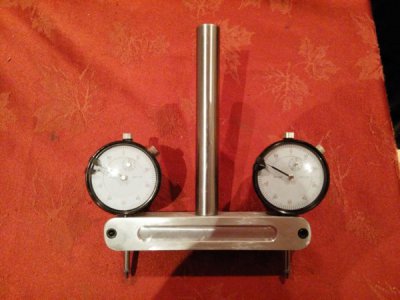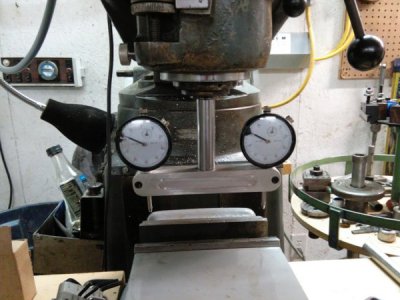-
Welcome back Guest! Did you know you can mentor other members here at H-M? If not, please check out our Relaunch of Hobby Machinist Mentoring Program!
You are using an out of date browser. It may not display this or other websites correctly.
You should upgrade or use an alternative browser.
You should upgrade or use an alternative browser.
Homemade tram tool
- Thread starter Leggman
- Start date
- Joined
- Feb 1, 2015
- Messages
- 9,605
I've never seen a three point tram tool.
But, I am wondering if the use of a disc or plate instead of a bar with three holes and three gages would allow for simultaneously tramming of nod and tilt.
Daryl
MN
I would think it would work but the prevailing design has the indicators diametrically opposite each other so an adjustment in one axis doesn't affect the other axis. Using a three point indication spaced 120º apart, the adjustments affect both axes. I have a laser level that does just that. With the level, it isn't too difficult to make an adjustment but it would be more annoying trying to adjust both trim and nod.
The third indicator could be mounted at right angles to the line between the first two but then the sensitivity would be halved as sensitivity is proportional to the distance between the indicators.
- Joined
- Aug 29, 2016
- Messages
- 838
Not to threadjack, but I've been wondering why people use 2 (or 3) indicators? As I see it, a single indicator on a sturdy offset arm should be sufficient.
- Joined
- Feb 1, 2015
- Messages
- 9,605
Not to threadjack, but I've been wondering why people use 2 (or 3) indicators? As I see it, a single indicator on a sturdy offset arm should be sufficient.
If you use a single indicator, you have to read, adjust, rotate, read, adjust, etc. Not difficult and the original way to do it. We do it all the time when we zero a four jaw chuck on the lathe.
With a dual indicator tramming tool, we zero the indicators and rotate to the axis we are tramming and adjust until they read the same. Done.
- Joined
- Aug 29, 2016
- Messages
- 838
Okay, that's the part I am missing. How do you zero the two indicators to be true normal to the spindle? What is the initial plane of reference?
- Joined
- Mar 19, 2014
- Messages
- 2,681
You are not missing anything! You have pointed out the BIG FLAW in that contraption! Why some people love that thing is beyond me! It needs to be calibrated every time you set it up! I’m very happy with using just one indicator. Marketing just loves to try and sell us new toys for our shop. A few are good ideas, but most are just a waste of money IMO.Okay, that's the part I am missing. How do you zero the two indicators to be true normal to the spindle? What is the initial plane of reference?
You are not missing anything! You have pointed out the BIG FLAW in that contraption! Why some people love that thing is beyond me! It needs to be calibrated every time you set it up! I’m very happy with using just one indicator. Marketing just loves to try and sell us new toys for our shop. A few are good ideas, but most are just a waste of money IMO.
I'm a novice machinist, pre-apprentice, but I have been doing sheetmetal layout/fabrication and welding since high school (a long time). The same question still comes up when I see 2-3 devices checking for accuracy between the cutter and the product; Why? Now we're counting on all the devices in between, those that are suppose to be accurate to .0005" to provide accuracy.
- Joined
- Mar 19, 2014
- Messages
- 2,681
If I understand your question? Yes, the more contraptions you have in your set-up. The more uncertainties you will have. Just keep it simple!!! The simpler the better!!! With my projects, I usually sleep on it, toss ideas around and the next day will have a simple, fast and accurate way of making. And NOT with buying any new marking toys that I don’t need, good luck, Dave.I'm a novice machinist, pre-apprentice, but I have been doing sheetmetal layout/fabrication and welding since high school (a long time). The same question still comes up when I see 2-3 devices checking for accuracy between the cutter and the product; Why? Now we're counting on all the devices in between, those that are suppose to be accurate to .0005" to provide accuracy.
- Joined
- Dec 27, 2014
- Messages
- 4,056
I use one .0005 indicator, with an 8" offset, gives me 16 inches of difference, far more accurate than 5". I guess that's 3.2 times the accuracy.



